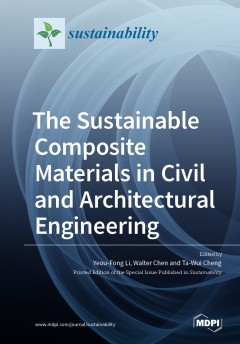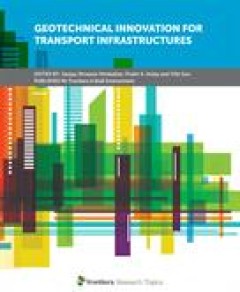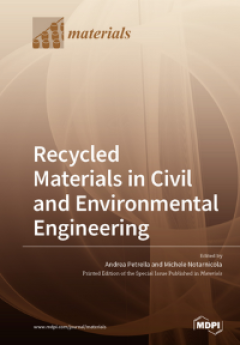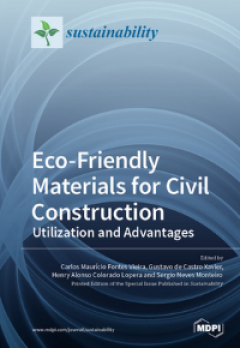Ditapis dengan

Engineered Wood Products for Construction
Wood is a gift from nature. It is a sustainable and renewable bio-composite material that possesses a natural ability to mitigate carbon dioxide. However, due to deforestation and climate change, it has become necessary to develop alternative building and construction materials. Engineered wood products (EWPs) such as parallel strand lumber, laminated veneer lumber, and cross-laminated timber a…
- Edisi
- -
- ISBN/ISSN
- 978-1-83962-790-3
- Deskripsi Fisik
- 358 Hlm.
- Judul Seri
- -
- No. Panggil
- -

The Sustainable Composite Materials in Civil and Architectural Engineering
This book is a collection of 10 research articles (from 18 submissions) authored by researchers and peer reviewed by professionals in the field to address the use of sustainable composite materials in civil and architectural engineering over the course of more than 2 years. Fiber-reinforced plastic (FRP), geopolymers, and various recycled and repurposed waste materials are among the items addre…
- Edisi
- -
- ISBN/ISSN
- 978-3-0365-3502-9
- Deskripsi Fisik
- 182 Hlm.
- Judul Seri
- -
- No. Panggil
- -

Sandy Materials in Civil Engineering : Usage and Management
As the world moves further into urbanization, there is a greater need for construction materials to meet society’s needs. As natural resources become scarce, the use of recycled materials for construction purposes has become increasingly common. Over the past decade, there has been a significant increase in the utilization of recycled materials in the construction industry. This will result i…
- Edisi
- -
- ISBN/ISSN
- 978-1-83962-982-2
- Deskripsi Fisik
- 142 Hlm.
- Judul Seri
- -
- No. Panggil
- -

Sand in Construction
Sand is commonly used in construction, often providing bulk, strength, and stability to other materials such as asphalt, concrete, mortar, render, cement, and screed. This book presents recent advances in the sand in construction techniques with special emphasis on contemporary issues in non-destructive testing (NDT) and evaluation. Chapters cover such topics as the origin, classification, and …
- Edisi
- -
- ISBN/ISSN
- 978-1-80355-587-4
- Deskripsi Fisik
- 110 Hlm.
- Judul Seri
- -
- No. Panggil
- -

Civil Engineering and Symmetry
A topic of utmost importance in civil engineering is finding optimal solutions throughout the life cycle of buildings and infrastructural objects, including their design, manufacturing, use, and maintenance. Operational research, management science, and optimization methods provide a consistent and applicable groundwork for engineering decision-making. These topics have received the interest of…
- Edisi
- -
- ISBN/ISSN
- 978-3-03921-003-9
- Deskripsi Fisik
- 200 hlm.
- Judul Seri
- -
- No. Panggil
- -

Geotechnical Innovation for Transport Infrastructures
Geotechnical problems in transportation and transit systems can lead to significant and costly unplanned maintenance and renewal of transport infrastructures built above the ground. Providing safe, efficient and sustainable transport infrastructure can be challenging owing to complex geotechnical aspects of the ground. Design considerations of rail transport embankments have become critical in …
- Edisi
- -
- ISBN/ISSN
- 978-2-88963-841-3
- Deskripsi Fisik
- 121 hlm.
- Judul Seri
- -
- No. Panggil
- -

Recycled Materials in Civil and Environmental Engineering
This book is a complete compilation of the latest research, innovation, and application studies related to the use of recycled materials in various fields of civil and environmental engineering. This book presents a collection of abstracts from leading researchers, engineers and practitioners who have contributed to developing the field and promoting sustainable practices. With the growing use …
- Edisi
- -
- ISBN/ISSN
- 978-3-0365-5233-0
- Deskripsi Fisik
- 354 hlm.
- Judul Seri
- -
- No. Panggil
- -

Eco-Friendly Materials for Civil Construction: Utilization and Advantages
This book takes the reader on an exploratory journey of environmentally friendly materials that are increasingly important in the civil construction industry. This book aims to provide in-depth insight into the use of sustainable materials in various construction projects and illustrate the significant advantages that can be derived from this environmentally friendly approach. This book is a v…
- Edisi
- -
- ISBN/ISSN
- 978-3-0365-7086-0
- Deskripsi Fisik
- 232 hlm.
- Judul Seri
- -
- No. Panggil
- -

Risk Management in Construction Projects
A project risk could be described as anything that could impact the fundamentals of a project performance timeline, performance, or budget. So, risk management, then, could be described as the deliberate processes of identifying, categorizing, prioritizing, and planning for risk occurrences before they disrupt project delivery. This book has contributions from diverse fields in the construction…
- Edisi
- -
- ISBN/ISSN
- 978-1-83962-218-2
- Deskripsi Fisik
- 100 hlm.
- Judul Seri
- -
- No. Panggil
- -

Numerical Modeling in Civil and Mining Geotechnical Engineering
This book presents current approaches in applying numerical models to address challenges in civil and mining geotechnical engineering. This book aims to provide in-depth insights into how numerical modeling technology has helped practitioners and researchers to address the complexity of geotechnical problems, understand the behavior of geotechnical materials, and plan and design geotechnical st…
- Edisi
- -
- ISBN/ISSN
- 978-3-0365-5442-6
- Deskripsi Fisik
- 302 hlm.
- Judul Seri
- -
- No. Panggil
- -
 Karya Umum
Karya Umum  Filsafat
Filsafat  Agama
Agama  Ilmu-ilmu Sosial
Ilmu-ilmu Sosial  Bahasa
Bahasa  Ilmu-ilmu Murni
Ilmu-ilmu Murni  Ilmu-ilmu Terapan
Ilmu-ilmu Terapan  Kesenian, Hiburan, dan Olahraga
Kesenian, Hiburan, dan Olahraga  Kesusastraan
Kesusastraan  Geografi dan Sejarah
Geografi dan Sejarah